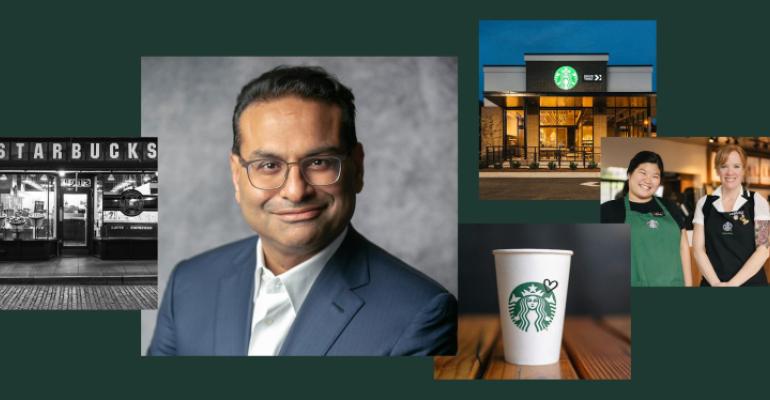Starbucks CEO Laxman Narasimhan — one of many retail leaders that presented at the annual Morgan Stanley Global Consumer & Retail conference— discussed the company’s goals and strategies for innovation, customization, and further improving the employee experience in a Q&A during the conference on Dec. 5. Despite Starbucks’ continued leadership in the foodservice space — including record revenues last quarter — Narasimhan said during the conversation that he thinks the company could “do better” with staffing and scheduling.
“It was very clear to me working in stores, that we could do better there, in how we match demand and supply, and how we get more personalized in terms of what the partners want,” he said. “We're not fully there yet…. There’s a lot more operational stability in the stores…. The topic of scheduling has been a big area of work and there’s more to come.”
Narasimhan added that as part of improving the employee experience, the company has already increased average compensation by 50% and by 2025, it will be effectively doubled. Employee resources around flexible and competent scheduling has been one of the main asks of the Starbucks Workers United campaign, as the union works to create individual store contracts for unionized stores and baristas. One of the reasons union workers organized walkouts on the company’s popular Red Cup Day this year was to protest the lack of resources around one of the busiest days of the year for many Starbucks cafes.
“The level of math, the level of technology that's going into it -- and we have a large number of shifts available for our network,” Narasimhan said. “Even people who want to work for 20 hours or 30 hours. It’s a very complex set of teams working really hard around how we unpack all that, and there's more to come.”
Besides continued employee improvements, here are some other topics Narasimhan touched upon:
More environmental oversight
Last month, Starbucks announced its intent to create a new environmental, partner and community impact board committee, which would assist the Starbucks board as it responds to shifting standards, and also hold the board accountable for adherence to these standards. It appears that sustainability will become a more pressing concern for Starbucks moving forward:
“If you look at what's coming with regard to the changes taking place and regulations, particularly on climate, if you look at the assessments that we've been doing internally, we felt it was appropriate to put a committee together that would actually oversee what we do in this entire space,” Narasimhan said “…. We are embedding a lot of the sustainability ideas into how we do this. With almost every single touch point that we have in the productivity program, there is a question around, ‘how do you ensure that sustainability is built into what we do?’ So it will have an impact on waste reduction, for example.”
Potential for more food innovation
Although Narasimhan clarified that Starbucks will always be a “beverage-first” company, he thinks there is significant opportunity in the food innovation space, particularly with ideas like all-day breakfast.
“We have a food attach opportunity,” he said. “What we see from our customers is they would like all-day breakfast, they would like all-day snacking, they would like to find a way to attach our food to the beverages they buy…. I think there's a real play in the afternoon that we haven't fully tapped into yet, and that's going to require innovation, it's going to require digital, it's going to require customization, and it’s going to require food attach.”
Significance of digital opportunity
With the success of its loyalty partnership with Delta, Starbucks has previously teased future partnerships with other hospitality companies and financial institutions, so customers can earn points in multiple ways.
“There are digital businesses that we incubating, even on top of all of this, that will actually help us further scale what we do there outside the store,” Narasimhan said. “There are different profit pools available… the digital opportunity is actually quite significant. It drives business to the stores, it makes people stop in more frequently. It also gives us the ability to add more to what they do.”
How they could use AI
One aspect of Starbucks’ future that the company has been pretty quiet about is its relationship with futuristic technology like NFTs and generative AI. Narasimhan mentioned the importance of AI as a tool for building the type of customization that Starbucks wants.
“We’re still mid-journey of how we learn more about individual customers,” he said. “We built Deep Brew — our artificial intelligence and machine learning platform — and now as you see this tech change, we can take that across all the data that we have with our partners and customers and help paint individual pictures of each customer… it will make it easier to make offers that actually will make you even more loyal.”
Contact Joanna Fantozzi at [email protected]





